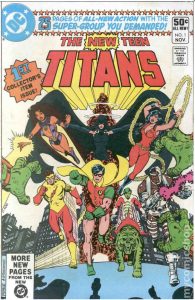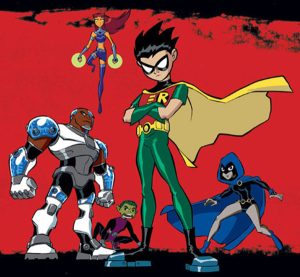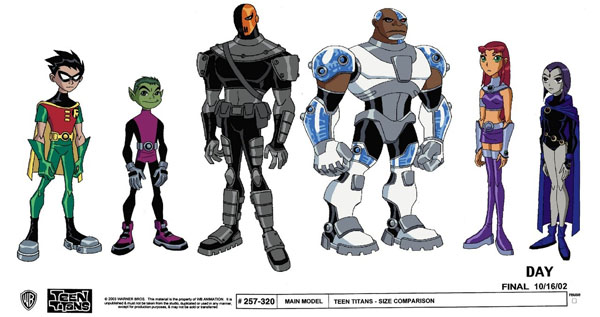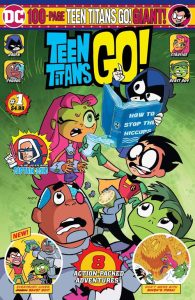Suspended Animation #382
How did the DC comics series Teen Titans become the Toon Titans? With the huge success of Batman: The Animated Series, Warner Brothers Animation was looking to exploit that popularity with other similar series including Superman: The Animated Series and several other Batman themed shows.
 The last twenty episodes of the original series were titled The Adventures of Batman and Robin because the network was looking to develop a spin-off to feature Dick Grayson’s adventures as he entered college. The Cartoon Network reran the original series from 1998 to 2004 and had expressed interest in a series that would focus on Robin.
The last twenty episodes of the original series were titled The Adventures of Batman and Robin because the network was looking to develop a spin-off to feature Dick Grayson’s adventures as he entered college. The Cartoon Network reran the original series from 1998 to 2004 and had expressed interest in a series that would focus on Robin.
DC’s original Teen Titans – a superhero group consisting of the kid sidekicks of several popular DC superheroes – made its debut in an issue of The Brave and The Bold (#54) in 1964. The group, sans Robin, was one of several segments that formed part of The Superman/Aquaman Hour of Adventure (1967). Filmation produced a grand total of three, 7-minute stories featuring the Teen Titans.
The comic book continued to thrive since then, adding members – including original characters like Beast Boy, Cyborg and Raven. Senior Vice President of Content Development Sam Register was a huge fan of the Marv Wolfman/George Perez version of the New Teen Titans that had appeared in DC comics starting in October 1980. After the pair left the series, the membership and story approach changed significantly.
 Register contacted Paul Levitz at DC Comics to find out if the property was available. In 1983, Hanna-Barbera had been developing a “New Teen Titans” cartoon series which was going to replace Super Friends (1980) but it never went beyond early development.
Register contacted Paul Levitz at DC Comics to find out if the property was available. In 1983, Hanna-Barbera had been developing a “New Teen Titans” cartoon series which was going to replace Super Friends (1980) but it never went beyond early development.
Register had felt the other superhero shows on Cartoon Network appealed to an older audience and wanted to produce one that targeted six to eleven year olds so using younger characters might be a good approach to establish a relatability factor. He also felt that using Robin would attract an audience who might be unfamiliar with the other characters.
The Teen Titans consisted of its leader Robin, Starfire (an alien princess with superpowers), Cyborg (who was half human and half robot with strength and technological skills), Raven (a girl from the world of Azarath who wielded dark energy powers) and Beast Boy (a jokester who could transform into various animals). The series was not allowed to use Wonder Girl even though she appeared in the comic books because the entire “Wonder franchise” was committed elsewhere.
They operated out of a T-shaped building called the Titans Tower on an island offshore of the West Coast metropolis Jump City.
 The show was a hit and ran for five seasons from July 2003 to January 2006 as well as a straight-to-video feature film entitled Teen Titans: Trouble in Tokyo (2006). There are conflicting reasons why the series was cancelled during its fifth season.
The show was a hit and ran for five seasons from July 2003 to January 2006 as well as a straight-to-video feature film entitled Teen Titans: Trouble in Tokyo (2006). There are conflicting reasons why the series was cancelled during its fifth season.
Register stated, “Part of what we like to do is surprise people. We want them to tune in because they aren’t quite sure what they’re going to get and if every show is the same straight adventure with a beginning, middle and end, I think you may not want to check out what’s on Teen Titans this week.
“I think doing these crazy episodes or even switching out the Japanese and English versions of the theme song…that’s us keeping the kids on their toes.
“Marv and George obviously created something that touched us as fans and we felt like we wanted to go back and redo it. It had such an effect that we actually really wanted to go back and do it again.”
Season one is about Robin fighting Slade. Season two is about the team fighting Terra and Slade (based on the Judas Contract storyline from the Wolfman/Perez comic book stories). Season three is about Cyborg fighting Brother Blood. Season four is about Raven fighting Trigon.
Season five is about Beast Boy fighting the Brotherhood of Evil. The movie featured the Titans traveling to Tokyo where they find themselves embroiled in a conflict with a supposedly mythological enemy.
The show was developed by Executive Producer Glen Murakami along with writers David Slack, Amy Wolfram and Rob Hogee. Marv Wolfman, who wrote for the comic series, wrote two episodes, one of which was “Deep Six” featuring Aqualad and the other, “Titans East”, for the third season that introduced other young superheroes that the studio hoped to spin-off into another series.
As Wolfman told writer Glen Cadigan about working on the series, “The characters have names and light background things that are similar but they’re completely different than the characters George and I created. I don’t think of them as my characters when I write them. I approach it the same way I would (the animated series) G.I. Joe where I see what they are doing and try to mimic what they’re doing, not try to do what I would do.”
Perez told Cadigan, “I say this is a fun, children’s version of our characters with a very wonky and surreal, almost Tex Avery-like animation feel mixed with the manga influence. My first impression was that it was not something that was for me but I have come to see that everyone is enjoying it, both producing it and the kids who are watching it. More people have seen a Titans cartoon then ever read a Titans comic.”

Glen Murakami was interviewed by Bill Walko about the series and said, “I think the thing we tried with Titans was an ‘anything goes’ approach. We didn’t know whether or not it would work but we didn’t want it to be the typical superhero show. I think sometimes people say ‘Well, you guys are just doing fake anime’ but I don’t think they realize how difficult it is to do that stuff.
 “We talked about exaggerating everything. I think it’s not so much ‘ripping off anime’ as it’s a kind of storytelling. I had seen Fooly Cooly (FLCL) before working on Titans so that became a reference.
“We talked about exaggerating everything. I think it’s not so much ‘ripping off anime’ as it’s a kind of storytelling. I had seen Fooly Cooly (FLCL) before working on Titans so that became a reference.
“Sam (Register) wanted to focus mainly on the Marv Wolfman/George Perez stuff and I was cool with that because that’s what I grew up reading. Every character had a different personality. I wanted to do approach Robin differently than what had been done on the previous Batman shows. I wanted to prove that Robin could be just as interesting as Batman.”
During its run, the series was nominated for three Annie Awards in 2004-2005 and one Motion Picture Sound Editors Award. The series spawned comics, DVD releases, video games, music albums, and collectible toys.
In 2013, the show inspired a spin-off series titled Teen Titans Go! In September 2019, a crossover film was released, titled Teen Titans Go! Vs. Teen Titans. Officially, neither series was considered part of the DC Animated Universe.
The never produced sixth season would have used the character Mr. Twister, another Mad Mod episode and perhaps the Ravager although there were concerns the character was too similar to Terra.
The original series continues to enjoy a healthy “after-life” in reruns.


 Jim Korkis is an internationally respected animation historian who in recent years has devoted his attention to the many worlds of Disney. He was a columnist for a variety of animation magazines. With his former writing partner, John Cawley, he authored several animation related books including The Encyclopedia of Cartoon Superstars, How to Create Animation, Cartoon Confidential and Get Animated’s Animation Art Buyer’s Guide. He taught animation classes at the Disney Institute in Florida as well as instructing classes on acting and animation history for Disney Feature Animation: Florida.
Jim Korkis is an internationally respected animation historian who in recent years has devoted his attention to the many worlds of Disney. He was a columnist for a variety of animation magazines. With his former writing partner, John Cawley, he authored several animation related books including The Encyclopedia of Cartoon Superstars, How to Create Animation, Cartoon Confidential and Get Animated’s Animation Art Buyer’s Guide. He taught animation classes at the Disney Institute in Florida as well as instructing classes on acting and animation history for Disney Feature Animation: Florida.




















































“…a vey wonky and surreal, almost Tex Avery-like animation….” Oh, no. No no no no no no. Not even close.
To say that the Teen Titans have enjoyed “a healthy afterlife in reruns” is a considerable understatement. Both series have been staples of afternoon cartoon programming blocks for a decade now, alternating so indiscriminately that I wasn’t even aware they were two different shows. I just thought some episodes used chibi versions of the characters. The downside to Sam Register’s goal of surprising people, of “keeping the kids on their toes” so that “they aren’t quite sure what they’re going to get,” is that it made the show awfully hard to grasp for people like me who had never read the comic books. Watching it always gave me the feeling that inside jokes were flying fast and thick all around me. I don’t get that with DC Super Hero Girls.
At least the history of the Teen Titans franchise makes sense to me now, even if the cartoons themselves never did.
Yeah, I still don’t get why out of all the DC Nations shorts, Sam choosed those “Teen Titans” exaggrations shorts as a full series instead of Laura Faust’s “Super Best Friends Forever”.
Even when we ended up getting a version of her series, it’s still being overshadowed by those oboxious Mad Magazines type versions of the Titans even though the internet community hates them.
Excellent article. I would point out that Beast Boy was not created as an “original” addition to Teen Titans. He was first introduced in DC Comics in DOOM PATROL #99 (1965) and was a member of that team, joining a couple of different incarnations of the Teen Titans much later.
Just one small note: Beast Boy was not original to the Titans. He was a Doom Patrol character from 1965, who joined the Titans briefly in the Titans West splinter group in 1977. He was picked up again for the Wolfman/Perez New Teen Titans run in 1980, during which he was renamed Changeling. That name lasted for many years before he reverted back to the Beast Boy name.
Filmation only did three “Teen Titans” episodes? I was under the impression that it was a little more than that, but then again this is Filmation we are talking about.
They were a part of “The Superman and Aquaman Hour of Adventure.” The Flash, Green Lantern, Hawkman, the Atom, and the Justice League were also featured in exactly three episodes each. (These are now available as part of “The Adventures of Aquaman” on HBO Max–at least, for the moment; the new boss’s plan to turn that channel into nothing but home improvement shows has only just started.)
Those early appearances were very brief. It’s interesting to see how the Teen Titans have grown in popularity over the years, going from short segments to their own cartoon series.